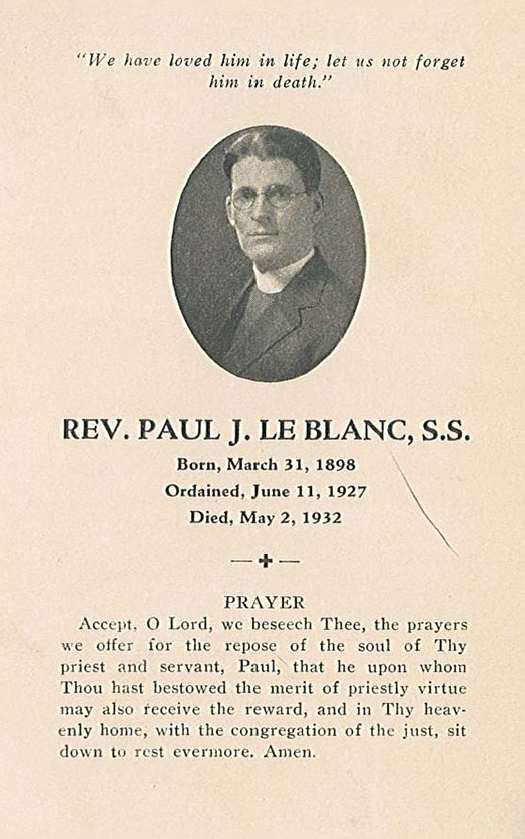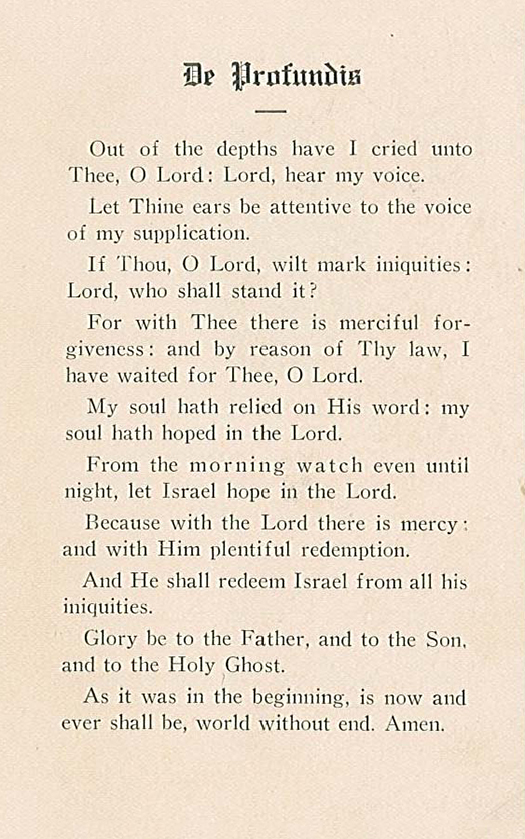LeBlanc, Father Paul
1932, May 2
Date of Birth: 1898, March 31
Issy
May 31, 1932
Fathers and Dear Confreres:
Last September the new Sulpician seminary, St. Edward’s, opened in the State of Washington. For a long time the seminary was desired by the Bishop of Seattle. The cornerstone was blessed by His Excellency, the Apostolic Delegate to the United States. The seminary was formally opened by His Eminence, Cardinal Dougherty, Archbishop of Philadelphia. The current school year seemed rich with promise for both students and teachers when disaster struck.
God did not, in effect, let the first year of Seattle’s seminary end happily. One of its faculty, the Treasurer, our confrere, Father Paul J. LeBlanc – the one who, with the new Superior of Seattle, was there from the beginning – was suddenly, to the distress of his family, his colleagues, and his students, taken away by a death as tragic as it was unforeseen.
Paul J. LeBlanc was born on March 31, 1898, in the Diocese of Grand Island. His family was of Acadian origin and was very large: seventeen brothers and sisters, of whom thirteen are still living, formed the crown, much loving and loved, of his worthy parents. They were staunch and fervent Catholics. Quite far away from any priest (in a diocese which had only a few priests), the LeBlancs lived their religious faith to the fullest. In their home each evening, father, mother, brothers, sisters, guests, and servants recited the rosary together. Is it any wonder if, in an atmosphere where the Christian life was so prized, two of Paul LeBlanc’s sisters entered the convent, several converted their Protestant husbands, and he himself decided to dedicate himself to the service of the Church and God?
In 1917, with this in mind, he entered the seminary in Menlo Park, in the Diocese of San Francisco. There he made his classical studies and two years of Philosophy. His life there was that of a model seminarian. Very quickly he came to admire the work of his teachers and to experience an attraction for their vocation. He had already learned that the great work of the Church is in forming priests – holy, learned, zealous – capable, in consequence, of extending and enhancing their blessed influence in the world. So he expressed the wish of being admitted to the Society of St. Sulpice. His wish was granted.
From 1923 to 1927, he was a student at the Sulpician Seminary in Washington. His fellow seminarians of the time happily recall the fraternal concern with which he made newcomers welcome. His charity, which inclined him to do everything for everybody, as much when he was being helpful in clearing up a question in Theology as when there was need of adding a little life and joy to the conversation. His proverbial heartiness, his rich imagination, the stories he told so interestingly and in which it was not always easy to distinguish history from legend – these things made him popular. His spirit of religion, his deep piety, his supernatural understanding of the rule, his affectionate respect and gratitude for his teachers, and his friendship with his fellow seminarians caused everyone to respect him, to love him, and to readily take him as a model in the great work of preparation for orders which was facing the whole seminary.
On June 11, 1927, after crossing the American continent, Father Paul LeBlanc was ordained priest by Bishop O’Dea in the Seattle cathedral. His family had lived in that diocese for several years. He had been incardinated into it.
In September, 1927, Father LeBlanc was sent as an auxiliary to Mountain View in the Diocese of San Francisco. He was to work there for a year in the Sulpician minor seminary where he had been a student himself.
During 1928-1929, Father LeBlanc was at the Solitude in Baltimore. It was that year that the project was under way for the opening of a seminary in Hanoi. Father LeBlanc heard of it. With his spirit of faith and his usual generosity he volunteered to become one of the first Sulpicians of the Far East. Accepted in principle, his wish could not be carried out right away, and circumstances obliged our confrere to await the carrying out indefinitely.
Meanwhile Father LeBlanc received from the Provincial Superior in the United States his first Sulpician assignment. It was for Seattle, his own diocese, where two years previous he had been ordained to the priesthood. Father LeBlanc was put at the disposal of His Excellency, Bishop O’Dea, for all the business of ordering material for the construction of a seminary and its disposition. He stayed there a year. In the course of that year, without talking about the task assigned to him, our confrere made St. Sulpice known and understood by the Seattle clergy, and by the faithful of the city and diocese. At the same time he was exercising his zeal with the poor, with sailors, and with a great many others who had given up the practice of their religion.
The year 1930-1931 briefly took Father LeBlanc away from Seattle. He spent it at St. Patrick’s Seminary in Menlo Park. There he was assigned to teach Biology.
But in August, 1931, he found himself recalled to Seattle, to the new St. Edward’s Seminary which he had helped to build. At the same time he continued there the teaching of Biology. He was given a Religion class and he was made Treasurer.
In these multiple roles, as well as in the help he was asked to give outside the seminary, Father LeBlanc gave evidence of a more than ordinary supernatural spirit and of extremely varied human qualities.
A man of profound faith and one inflamed with zeal for the salvation of souls, in the hours left to him after his teaching and administrative duties he took up again his shining life outside the seminary.
Item: Here is a woman who has lost the faith. To bring her back to religion and to God, he forgets food and drink, grabs hold of her soul, enjoys shaking it up, mauling it, grabbing it again, and finishes by bringing it back to a regular reception of the sacraments.
Item: This time it is in a bus. A young man and woman tell him they were not married in church. He arranges a meeting with them at the Cathedral, hears their confessions, and regularizes their marriage.
Item: Another day on a streetcar, having given up his seat, he takes another. His neighbor says to him, “Father, I’m not fit to sit next to you.” “Why?” asks Father LeBlanc. “Because I haven’t been to the sacraments for years.” Father LeBlanc reassured him. They began a conversation. And the next day Father LeBlanc heard his confession. It was, it seems, a regular thing.
The outside involvements – occasioned by conditions in which the diocese where he was working found itself – did not keep him from giving himself thoroughly to his seminary work. If he went out, it was through obedience, for one very special object of his assignment was to make lay Catholics aware of the meaning and importance of the training which young men receive in the seminary. Loving the hidden life, very anxious to give himself to prayer, desirous of studying Holy Scripture (and particularly St. Paul’s epistles), he would have preferred to consecrate himself entirely to the important work of priesthood-training and to shun the world completely. The students thought highly of him and loved him. When he was upset or had gone too far in punishing them, he told them he was sorry and apologized. All had the impression that he loved them in a special way, gave himself to each one without holding back, and spent himself personally for their sakes. Familiarly and respectfully he was called “the friend of friends” as a sign of the value and universality of his friendship. A priest who knew him well and with whom Father LeBlanc had worked said of him: “In my humble opinion, his influence for good is explained by the fact that he had reached a high degree of prayer and intimate union with Christ.”
With such qualities of nature and grace, Father LeBlanc’s influence on our American seminaries would have been very much a blessing and very deep. But God willed otherwise.
On last May 2nd, after observing the anniversary of his mother, for whom he had said Holy Mass that morning, Father LeBlanc was canoeing on Lake Washington a little out from the shore when his craft overturned. He was a good swimmer but a cramp must have kept him from staying afloat. His body was found the next day. His hands were raised and joined as if in a final prayer, the prayer of one whose only hope is in God.
The body was first brought to the seminary. On the evening of Friday, May 6th, the Office of the Dead was sung at the Cathedral. The next day, Saturday, the funeral took place. His Excellency, Bishop O’Dea of Seattle, graciously presided. Father Mulligan, Superior of St. Edward’s, sang the Mass, assisted by two of our confreres. Two others were chaplains to Bishop McGrath of Baker City, who gave the absolution. The Reverend Father Abbot, Dom Lambert; Monsignors Stafford, Noonan, Sweeney, and Ryan; as well as about sixty priests of the diocese, came to pay their last respects to our confrere. Monsignor Stafford, Rector of the Cathedral, who knew Father LeBlanc well, preached the eulogy, a very touching tribute.
Afterwards, the body was carried to the seminary. It was buried on the grounds in a spot chosen to serve as a cemetery for the new Sulpician community.
There is no question that the confreres and students of Father LeBlanc will often think of him and frequently pray for him. From afar we shall join our prayers to theirs in order to strengthen, if that is possible, the ties of friendship and brotherly collaboration we have with them.
Please accept, Fathers and dear confreres, the expression of my respectful and very devoted affection in Our Lord.
P. Boissard
Vice-superior of St. Sulpice


